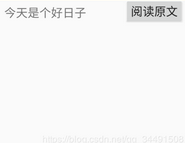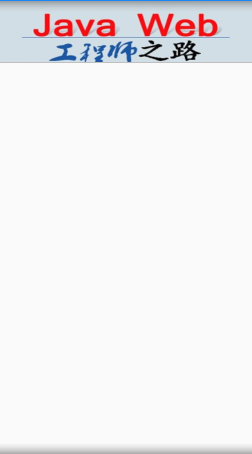- 1C++可调用Callable类型的总结_callable撖寡情c++
- 2Java 日期Calendar 计算两个日期之间的差值_java中的calendar计算两个时间差
- 3【百度Apollo】探索自动驾驶:新版本 Beta全新升级算法方向支持4D毫米波,引入新模型提供增量训练
- 4搜索趋势:微软必应新版集成AI和实时搜索_biyingai csdn
- 5复杂网络知识点讲解以及代码实现_复杂网络分析代码
- 6Windows AppData介绍_local文件夹能删除吗
- 7AngularJS快速上手,从安装到运行_angularjs安装
- 8微信小程序开发系列(三十二)·如何通过小程序的API实现页面的上拉加载(onReachBottom事件)和下拉刷新(onPullDownRefresh事件)_微信小程序 onreachbottom
- 9【JAVA】JWT令牌生成和解析(库:jjwt 版本:0.12.3)_java jwt 生成 与解析
- 10mysql自带的information_schema.tables是什么?_information.schema.tables
Android控件之高级控件——ListView、cardView、屏幕适配_cardview listview
赞
踩
一:ListView
1.什么是ListView
如下通过一行行列表视图展示数据的一种控件,应用场景比如通讯录、短信列表、聊天联系人、文件夹列表、评论列表、应用列表等

2.Layout中如何实现ListView
第一步:layout中创建ListView
- <?xml version="1.0" encoding="utf-8"?>
- <LinearLayout xmlns:android="http://schemas.android.com/apk/res/android"
- xmlns:app="http://schemas.android.com/apk/res-auto"
- xmlns:tools="http://schemas.android.com/tools"
- android:layout_width="match_parent"
- android:layout_height="match_parent"
- tools:context=".MainActivity">
- <ListView
- android:id="@+id/list_item"
- android:layout_width="match_parent"
- android:layout_height="match_parent"/>
- </LinearLayout>
效果

第二步:创建每一行的Layout。item.xml
- <?xml version="1.0" encoding="utf-8"?>
- <LinearLayout xmlns:android="http://schemas.android.com/apk/res/android"
- android:orientation="horizontal" android:layout_width="match_parent"
- android:layout_height="match_parent">
-
- <TextView
- android:id="@+id/list_item"
- android:layout_width="wrap_content"
- android:layout_height="wrap_content"
- android:layout_gravity="center_horizontal"
- android:layout_marginLeft="30dp"
- android:paddingTop="12dp"
- android:text="今天是个好日子"
- android:textSize="24dp" />
-
- <Button
- android:layout_width="wrap_content"
- android:layout_height="wrap_content"
- android:textSize="24dp"
- android:text="阅读原文"
- android:layout_marginLeft="90dp"/>
- </LinearLayout>

效果

第三步:使用adapter将数据填充到每一行的视图中
- public class MainActivity extends AppCompatActivity {
-
- @Override
- protected void onCreate(Bundle savedInstanceState) {
- super.onCreate(savedInstanceState);
- setContentView(R.layout.activity_main);
- ListView listView = findViewById(R.id.list_item);
- List<String> list = new ArrayList<>();
- list.add("Android知识了解");
- list.add("Android开发环境搭建");
- list.add("Android控件学习");
- list.add("Android网络操作");
- listView.setAdapter(new ListAdapter(list));
- }
-
- public class ListAdapter extends BaseAdapter {
- List<String> names;
-
- public ListAdapter(List<String> list) {
- names = list;
- }
-
- @Override
- public int getCount() {//有多少条数据
- return names.size();
- }
-
- @Override
- public Object getItem(int position) {//获取当前postion位置的这条数据
- return names.get(position);
- }
-
- @Override
- public long getItemId(int position) {//获取当前postion位置的id
- return position;
- }
-
- @Override
- public View getView(int position, View convertView, ViewGroup parent) {
- //xml转成java代码操作
- LayoutInflater layoutInflater = (LayoutInflater) getSystemService(Context.LAYOUT_INFLATER_SERVICE);
- convertView = layoutInflater.inflate(R.layout.item, null);
- TextView textView = convertView.findViewById(R.id.item_text);
- Button button = convertView.findViewById(R.id.button);
- textView.setText(names.get(position));
- return convertView;
- }
- }
- }

效果

3.给ListView添加头部Header
我们要实现的需求如下,当我们向上翻动时候,顶部也会滚动

要实现以上的header效果,主要用到的方法就是ListView的addHeaderView(View view),需要一个view对象,所以我们创建一个header.xml的layout
- <?xml version="1.0" encoding="utf-8"?>
- <LinearLayout xmlns:android="http://schemas.android.com/apk/res/android"
- android:orientation="vertical" android:layout_width="match_parent"
- android:layout_height="match_parent">
- <ImageView
- android:layout_width="match_parent"
- android:layout_height="100dp"
- android:background="@mipmap/header"
- />
- </LinearLayout>
效果

java代码,只需在3中代码的onCreate方法加上以下代码
- //读取layout转成View
- LayoutInflater layoutInflater = (LayoutInflater) getSystemService(Context.LAYOUT_INFLATER_SERVICE);
- View header= layoutInflater.inflate(R.layout.header, null);
- listView.addHeaderView(header);
注:如果要实现翻滚列表但是顶部图片不随着翻动效果,我们只需将界面设计成顶部一个ImageView控件加上下面一个ListView控件
4.通过ListView展示手机所有应用列表
我们要实现的需求如下所示,展示所有应用列表,并且点击能够进入当前应用

这里每行的layout的xml文件发生了点变化,代码如下
- <?xml version="1.0" encoding="utf-8"?>
- <LinearLayout xmlns:android="http://schemas.android.com/apk/res/android"
- android:orientation="horizontal" android:layout_width="match_parent"
- android:layout_height="match_parent">
-
-
-
- <ImageView
- android:id="@+id/image"
- android:layout_width="wrap_content"
- android:layout_height="wrap_content"
- android:textSize="24dp"
- android:text="阅读原文"
- android:layout_marginLeft="10dp"
- />
- <TextView
- android:id="@+id/item_text"
- android:layout_width="wrap_content"
- android:layout_height="wrap_content"
- android:layout_gravity="center_horizontal"
- android:layout_marginLeft="30dp"
- android:paddingTop="12dp"
- android:text="今天是个好日子"
- android:textSize="24dp" />
- </LinearLayout>

整个java代码如下
-
- public class MainActivity extends AppCompatActivity {
-
- @Override
- protected void onCreate(Bundle savedInstanceState) {
- super.onCreate(savedInstanceState);
- setContentView(R.layout.activity_main);
- ListView listView = findViewById(R.id.list_item);
- final List<ResolveInfo> list = getAppInfos();
- listView.setAdapter(new ListAdapter(list));
- //添加每个item的点击事件
- listView.setOnItemClickListener(new AdapterView.OnItemClickListener() {
- @Override
- public void onItemClick(AdapterView<?> parent, View view, int position, long id) {
- String packageName = list.get(position).activityInfo.packageName;
- String className = list.get(position).activityInfo.name;
- ComponentName componentName = new ComponentName(packageName, className);
- final Intent intent = new Intent();
- intent.setComponent(componentName);
- startActivity(intent);
- }
- });
- }
-
-
- public class ListAdapter extends BaseAdapter {
- List<ResolveInfo> names;
-
- public ListAdapter(List<ResolveInfo> list) {
- names = list;
- }
-
- @Override
- public int getCount() {//有多少条数据
- return names.size();
- }
-
- @Override
- public Object getItem(int position) {//获取当前postion位置的这条数据
- return names.get(position);
- }
-
- @Override
- public long getItemId(int position) {//获取当前postion位置的id
- return position;
- }
-
- @Override
- public View getView(int position, View convertView, ViewGroup parent) {
- //xml转成java代码操作
- LayoutInflater layoutInflater = (LayoutInflater) getSystemService(Context.LAYOUT_INFLATER_SERVICE);
- convertView = layoutInflater.inflate(R.layout.item, null);
- TextView textView = (TextView) convertView.findViewById(R.id.item_text);
- ImageView imageView = (ImageView) convertView.findViewById(R.id.image);
- textView.setText(names.get(position).activityInfo.loadLabel(getPackageManager()));
- imageView.setImageDrawable(names.get(position).activityInfo.loadIcon(getPackageManager()));
- return convertView;
- }
- }
-
- //获取所有的应用信息
- private List<ResolveInfo> getAppInfos() {
- Intent intent = new Intent(Intent.ACTION_MAIN, null);
- intent.addCategory(Intent.CATEGORY_LAUNCHER);
- return getPackageManager().queryIntentActivities(intent, 0);
- }
- }

5.优化ListView
我们上面实现的ListView缺点就是如果数据很多的时候,我们每次翻动都会加载每个item进行渲染,我们可以通过缓存当前这个item达到优化
具体修改的代码如下
二:CardView
1.CardView是什么?
CardView是Android5.0之后新增的一个继承自FrameLayout,方便作为其他控件容器添加3D阴影和圆角效果,使用的时候需要独立引入com.android.support:cardview-v7:26.1.0
如下效果
2.CardView常用属性
app:cardBackgroundColor背景色
app:cardCornerRadius圆角半径
app:contentPadding内容padding
app:cardElevation阴影大小
cardUseCompatPadding 默认false,用于5.0以上,true则添加额外的padding绘制阴影
cardPreventCornerOverlap 默认true 用于5.0以下,添加额外padding防止内容和圆角重叠
三:屏幕适配
让我们的app使用不同尺寸、不同分辨率的设备,完成屏幕适配主要包括布局上的适配和图片上的适配
几个概念
屏幕尺寸:是屏幕对角线的长度单位是英寸,1英寸=2.54厘米,常见尺寸2.4、2.8、3.5、3.7、4.2、5.0、5.5、6.0
屏幕分辨率:指在横纵向上像素点数,单位是px,1px=1个像素点,一般以纵向像素*横向像素如1960*1080
屏幕像素密度:尺寸不变的情况下,分辨率越高屏幕越清晰屏幕像素密度越高,即屏幕像素密度指的是每英寸上的像素点数单位是dpi(求法就是首先根据三角形求出对角线上的像素,然后除以屏幕尺寸即可),
dp的范围划分

布局适配
1.禁用绝度布局
2.少用px作为单位,改用dp或者dip
3.合理使用wrap_content(先按照内容的多少设定控件大小,再按照权重比例分配)、match_parent(控件大小=父容器大小+权重比例*剩余空间大小)、layout_weight(0dp,直接按照你所设定比例分配)
图片适配
1.提供不容分辨率的图
2.使用自动拉伸图
文章首发地址:www.javayihao.top
文章首发公众号:java一号


